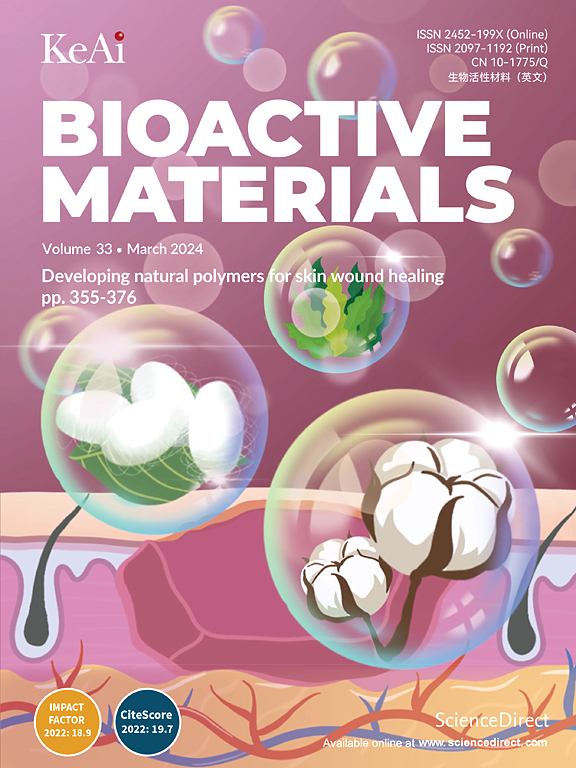Unraveling osteogenesis mechanisms of the empowered VitaFlux adaptive regeneration biomaterials for bone tissue engineering: Insights into the role of BBGs/BSBGs
IF 18
1区 医学
Q1 ENGINEERING, BIOMEDICAL
引用次数: 0
Abstract
Bone tissue engineering materials are crucial for bone repair, but existing repair materials still face many challenges, including poor biocompatibility and bioactivity, slow self-repair processes, limited adaptability, inability to promote angiogenesis and so on. To address these issues, the development of third-generation bone repair materials, which are being designed to stimulate specific cellular responses at the molecular level, such as borate and borosilicate bioactive glasses (BBGs/BSBGs) that activate cells and genes, offers new potential for promoting bone tissue self-renewing. Their unique characteristic lies in a flow of life-giving energy, releasing beneficial ions such as boron, calcium and silicon to stimulate cell proliferation and differentiation, accelerating the regeneration of bones. Through this dynamic repair mechanism, these VitaFlux glasses operate like a “living system” within the body, not only speeding up the healing of damaged tissues but also interacting seamlessly with surrounding tissues during the repair process. In this review, we provide a comprehensive analysis of the current understanding of the osteogenesis mechanisms of BBGs/BSBGs, emphasizing their interactions with cells, including ion release and exchange, protein adsorption, and cell adhesion. We also examine key osteogenic signaling pathways related to the alkaline and ionic microenvironments of BBGs/BSBGs, such as the cell cycle, Wnt, MAPK, and BMP signaling pathways, along with macrophage polarization and angiogenesis. Additionally, strategies and future prospects for advancing BBGs/BSBGs research are discussed. Special attention is given to the NaBC1 and GPCR-mediated signaling pathways, which require further investigation.

在骨组织工程中增强的VitaFlux适应性再生生物材料的成骨机制:洞见bbg /BSBGs的作用
骨组织工程材料是骨修复的关键,但现有的修复材料仍面临诸多挑战,包括生物相容性和生物活性差、自我修复过程缓慢、适应性有限、不能促进血管生成等。为了解决这些问题,第三代骨修复材料的开发,正在设计在分子水平上刺激特定的细胞反应,如激活细胞和基因的硼酸盐和硼硅酸盐生物活性玻璃(bbg /BSBGs),为促进骨组织自我更新提供了新的潜力。它们的独特之处在于生命能量的流动,释放有益的离子,如硼、钙和硅,以刺激细胞增殖和分化,加速骨骼的再生。通过这种动态修复机制,这些VitaFlux眼镜就像体内的“生命系统”一样运作,不仅加速了受损组织的愈合,而且在修复过程中与周围组织无缝互动。在这篇综述中,我们全面分析了目前对bbg /BSBGs成骨机制的理解,强调了它们与细胞的相互作用,包括离子释放和交换,蛋白质吸附和细胞粘附。我们还研究了与bbg /BSBGs的碱性和离子微环境相关的关键成骨信号通路,如细胞周期、Wnt、MAPK和BMP信号通路,以及巨噬细胞极化和血管生成。此外,还讨论了推进bbg /BSBGs研究的策略和未来展望。特别关注NaBC1和gpcr介导的信号通路,这需要进一步的研究。
本文章由计算机程序翻译,如有差异,请以英文原文为准。
求助全文
约1分钟内获得全文
求助全文
来源期刊

Bioactive Materials
Biochemistry, Genetics and Molecular Biology-Biotechnology
CiteScore
28.00
自引率
6.30%
发文量
436
审稿时长
20 days
期刊介绍:
Bioactive Materials is a peer-reviewed research publication that focuses on advancements in bioactive materials. The journal accepts research papers, reviews, and rapid communications in the field of next-generation biomaterials that interact with cells, tissues, and organs in various living organisms.
The primary goal of Bioactive Materials is to promote the science and engineering of biomaterials that exhibit adaptiveness to the biological environment. These materials are specifically designed to stimulate or direct appropriate cell and tissue responses or regulate interactions with microorganisms.
The journal covers a wide range of bioactive materials, including those that are engineered or designed in terms of their physical form (e.g. particulate, fiber), topology (e.g. porosity, surface roughness), or dimensions (ranging from macro to nano-scales). Contributions are sought from the following categories of bioactive materials:
Bioactive metals and alloys
Bioactive inorganics: ceramics, glasses, and carbon-based materials
Bioactive polymers and gels
Bioactive materials derived from natural sources
Bioactive composites
These materials find applications in human and veterinary medicine, such as implants, tissue engineering scaffolds, cell/drug/gene carriers, as well as imaging and sensing devices.
 求助内容:
求助内容: 应助结果提醒方式:
应助结果提醒方式:


